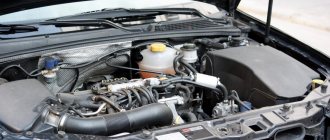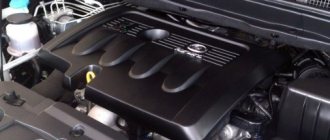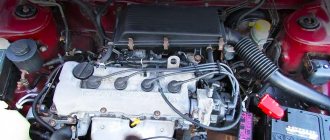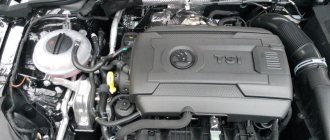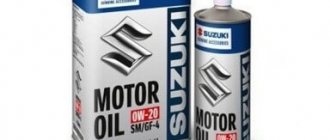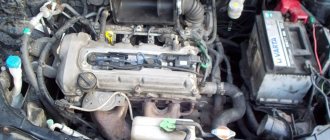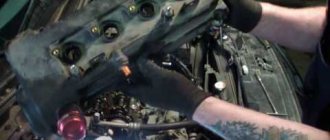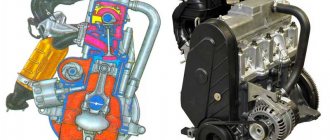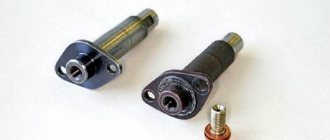Decoding the German engine encoding Opel A14Net
All German cars have a coded form of engine designation:
- the first letter confirms compliance with European requirements. In this version, the letter A determines compliance with Euro 5 emission standards;
- in the second and third places there is a number, when divided by 10 you can find out the volume of the cylinders. Here the number 14, divided by 10, gives the engine capacity of 1.4 liters;
- the next letter informs the driver about the compression ratio of the internal combustion engine. In this case, N corresponds to a compression ratio from 9.0 to 10. On A14Net it is 9.5;
- The following designation determines the type of fuel injection. Letter E indicates distributed multipoint injection;
- the last character in the name, the Latin letter T, indicates that the Opel A14NET engine is equipped with a turbine that allows the engine to develop power up to 143 hp.
Engine tuning Opel A14NET/NEL
Chip tuning Astra/Cruz 1.4 turbo
Unlike aspirated engines, where chip tuning is a very dubious task, here the situation is different and flashing the A14NET engine makes sense. There are a lot of companies with ready-made programs for your engine; at the same time, the catalyst is removed and the power rises to 160-180 hp. Doing something more, installing more efficient turbines, is neither profitable nor reasonable, for a 1.4 liter 180 hp. and so a very serious indicator.
Source
Technical data Opel A14Net
The A14Net engine has been produced by Opel Werk Aspern from 2010 to the present day.
The cylinder block is made of cast iron. Four-stroke, gasoline engine, the four cylinders of which are arranged in one row.
The power system is distributed point injection. DOHC gas distribution system consisting of two camshafts and 16 valves.
The exact cylinder volume is 1364 cubic cm. The engine power at 5500 rpm is 140 hp. Torque at 4900 rpm is 200 Nm.
The motor belongs to the type of power units in which the piston stroke length is greater than the diameter of the cylinders, 82.6 / 72.5, respectively. Such engines have increased efficiency and are called square.
Compliance with environmental requirements - Euro 5.
Fuel consumption in city mode is 8.1 liters per 100 km, mileage on the highway is 5.2 liters. Total fuel consumption is about 6.2 liters per 100 km.
The fuel used is not lower than AI 95.
How much oil is in the engine
Engine oil is 4 liters, pour 3.5 liters when changing. Only high-quality synthetic oils 0W30, 5W30 should be used. You need to change the oil no later than 15 thousand km, but it is better to halve this number.
Resource
According to the manufacturer, the operating life of the internal combustion engine is 350,000 kilometers before major repairs. In reality, with proper maintenance and driving without frequent acceleration, it can significantly exceed this figure.
Technical characteristics of the Opel A14NET 1.4 Turbo engine
| Exact volume | 1364 cm³ |
| Supply system | distribution injection |
| Engine power | 140 hp |
| Torque | 200 Nm |
| Cylinder block | cast iron R4 |
| Block head | aluminum 16v |
| Cylinder diameter | 72.5 mm |
| Piston stroke | 82.6 mm |
| Compression ratio | 9.5 |
| Features of internal combustion engines | VIS |
| Hydraulic compensators | Yes |
| Timing drive | chain |
| Phase regulator | DCVCP |
| Turbocharging | Yes |
| What kind of oil to pour | 4.0 liters 5W-30 |
| Fuel type | AI-95 |
| Environmental class | EURO 5 |
| Approximate resource | 300,000 km |
Service and repair manual posted on OpelClub
A large number of useful materials for cars are collected here
Forged pistons for such an engine are sold by Pistons STI
Description of the positive features of the Opel A14Net internal combustion engine
The main features of the A14Net engine include the use of turbocharging on a small engine. This feature makes the compact engine quite powerful and at the same time economical. So, at 143 liters, if you drive along the highway, fuel consumption can be about 5.2 liters per 100 km, mileage. It turns out to be a good combination of economy and power.
A roller chain is installed in the motor on the drive of the GR mechanism. This design is almost three times more durable than the timing belt used on other engines. It eliminates the possibility of rupture and destruction of pistons and valves. Even if the chain fails, it will not break, but will begin to rattle loudly. Replacing the chain and rollers will solve all problems.
Replacing the timing chain
Installed hydraulic compensators in the cylinder head facilitate automatic adjustment of valve thermal clearances. This eliminates the need to periodically perform expensive operations to regulate thermal clearances in the valves.
In the Opel a14net internal combustion engine, a system that changes valve timing is installed on all two camshafts. This system improves the dynamics of the car and contributes to the efficiency of this power unit.
The power of a small engine with a volume of 1.4 liters was significantly increased by equipping the power unit with a low-pressure turbine (about 0.5 bar). Despite the compact dimensions of the turbine, it was possible to obtain an engine with a power of up to 143 hp. The use of a turbocharger did not in any way deteriorate the durability and reliability of this power unit.
Malfunctions and repairs of the Astra/Cruz A14NET/NEL engine
The A14NET engine appeared in 2010 on the Astra J and other GM cars; its feature is the use of turbocharging on a small-volume engine. The engine uses timing chains, which significantly increases the reliability of the mechanism. Hydraulic compensators are used, so there is no need to adjust the valves; the operating temperature of the Opel Astra 1.4 turbo engine is 90 C. Among other things, a variable valve timing system with phase shifters on both shafts is used. But let’s get back to our turbine... the A14NET engine has a small turbine that inflates 0.5 bar of excess almost from idle and provides an even torque plateau and even, stable thrust. All this adds up to 140 hp. with a volume of 1.4 liters, as a result we have both efficiency and high-torque performance, some advantages... But not everything is so sweet, these advantages also lead to disadvantages, due to the high output per liter of volume, the engine is seriously loaded and is very demanding on the quality of the oil, it needs to be poured only high-quality official oil, and not your usual badya, otherwise the engine will say hello. If you intend to drive happily ever after, then you need to do this carefully and without unnecessary rigidity, without unnecessarily loading the engine, so that your turbine does not fall apart and the pistons do not crumble to hell. Let's look at the shortcomings of the engine, the typical problem of Opel engines remains, after a while oil will begin to leak through the valve cover gasket and no matter what mileage you have, whether the car is new or old, this is a common disease that requires replacement of the gasket. Astra/Cruz Ecotek 1.4 turbo engines like to make sounds reminiscent of a diesel engine, these are classic Opel engines with phase regulators. The pump on the A14NET engine often whistles, so if a strange, characteristic engine sound appears, go to a service center; a replacement will not cost you much. In addition, the air conditioner compressor bearing likes to make shuffling sounds; this is a very popular disease and 90% of owners cannot even understand what is happening. In addition to all these joys, there are also clicking sounds... Astra Motor generally likes to make a variety of sounds so that you don’t get bored, so the injectors make a clicking sound, this is normal, this is part of their job. Everyone also knows about vibrations, the engine likes to vibrate a little, there is nothing fatal in this either, it is a disease of all turbo astras/cruises/insingnia/mocks, etc. In general, the engine is good, modern, economical, with a number of systems and technologies for a quiet ride with periodic accelerations that's what you need. But it’s not very suitable for racing; for some races, look towards the A16XHT, A16LET or other more powerful options)) Since 2012, a simplified model of this engine called A14NEL, derated to 120 hp, has been installed. All the problems inherent in the 140 strong model are repeated on it.
Description of negative features
The features of a14net include a number of disadvantages.
- To produce more power, a small engine has to be heavily loaded. Therefore, the engine is very picky about the quality of oil . If low-quality motor oil is used on the A14Net internal combustion engine, its service life may be significantly reduced.
- Considering that the engine is heavily loaded, it is prone to problems such as oil leaks . There are several weak points in this regard: valve covers, crankshaft seals. If everything is simple with the valve cover, just replace the gasket, then you will have to seriously tinker with replacing the crankshaft seals. It’s better to entrust this work to service station specialists. Oil leaks, like other breakdowns, occur due to improper driving. Despite its decent power, the a14net does not like frequent changes in driving rhythm, constant acceleration and braking. At this rate, the engine quickly overloads and becomes vulnerable to malfunctions. If you use a gentle, constant driving style, this power unit will reliably serve for many years. And for fans of sporty driving, it is better to pay attention to engines that have a larger volume.
- The Opel A14Net engine is characterized by the appearance of specific sounds and vibrations . This should not be regarded as a motor malfunction. This situation is related to the design of the power unit, the presence of two phase distributors, the timing chain, and other mechanisms. Perhaps these systems periodically come into resonance and similar signs appear. There is nothing wrong with this feature of the internal combustion engine, especially since after some time the noise and vibration disappear without consequences.
Disadvantages, breakdowns and problems of A14NET
Motors of this series are famous for noise, clicking and whistling in operation, but this is normal
In second place are oil leaks from under the valve cover or crankshaft oil seal.
The sophisticated crankcase ventilation system causes a lot of problems for the owner.
The pump here has a short lifespan, but the turbine can give up after 100,000 km
In the first years of production, piston destruction was regularly encountered at low mileages.
You can contact the site administrator by email: [email protected]
All texts were written by me, are authored by Google, included in the original Yandex texts and notarized. For any borrowing, we immediately write an official letter on company letterhead in support of search networks, your hosting and domain registrar.
Next we go to court. Don’t try your luck, we have more than thirty successful Internet projects and have already won a dozen lawsuits.
Source
Possible malfunctions of the Opel A14NET and ways to eliminate them
The Opel A14Net engine has the following malfunctions:
Power Loss
1. When accelerating intensively, the engine may lose power without any preliminary signs. This problem can occur when the turbocharger fails. The reason is a stuck bearing. This is especially dangerous if the car is overtaking; a sudden loss of power can lead to an accident. To prevent this from happening, it is necessary to inspect the turbine area for signs of oil leakage. If oil appears in the area of the turbocharger, you need to be prepared for its breakdown and subsequent replacement.
Power loss 2
2. The a14net power unit may lose power gradually. At first this can be expressed in unstable idle speeds, then the engine will lose its former agility. There may be several reasons: there may be problems with the injector, ignition coils, injectors or phase regulators. A complete engine diagnostic will help identify the exact cause of the problem. On your own, without special equipment, you can only determine the problem at random.
Pump problems
3. If a pronounced metallic whistle begins to appear under load, this is an accurate sign of failure of the water pump. Replacing it will solve the unpleasant problem.
Crankcase ventilation
4. The system responsible for ventilation of crankcase gases can cause big problems. To simplify the implementation of the system, engineers created a cunning design, which in reality turned out to be unreliable.
That's it, its three main components periodically go out of working order:
- diaphragm located in the valve cover;
- a corrugated hose that goes to the turbine from the exhaust manifold;
- check valve located in the plastic intake manifold.
The most reliable of these elements is the corrugated hose; the rest often fail. The saddest thing is that if a simple problem is not corrected in time, an expensive turbine may fail.
Piston damage
5. The saddest thing that can happen to the A14Net internal combustion engine is the destruction of the pistons. The thing is that this engine, with frequent changes of operating modes, experiences enormous loads, which lead not only to oil leaks, but can also affect the integrity of the pistons. Usually the partitions between the rings responsible for engine compression are destroyed.
There are two main reasons for the destruction of the piston partitions:
- the first reason is the already known operation of the engine under high overloads;
- the second is the detonation that occurs as a result of the use of gasoline with a low octane number.
Problem solving, engine overhaul. But it is much easier to prevent the problem; it is enough to use high-quality gasoline and drive the car carefully and carefully.
Engine disadvantages
However, the engine is clearly not suitable for lovers of fast, aggressive driving. Rather, this is the lot of motorists who prefer a calm rhythm of movement with periodic accelerations. The new engine also has shortcomings that engineers were unable to eliminate.
- The engine is seriously loaded due to high recoil - the pistons can easily crumble.
- It is overly sensitive to the quality of the lubricant - only official oil should be poured. The lubricant must be replaced at least once every 10,000 km.
- The engine's environmental standards comply with Euro 5. Obviously, pouring gasoline with a low octane number into the engine will be more expensive - only 95 and higher.
Oil leak
During operation of the engine, the following shortcomings were also identified.
- After some time, regardless of the mileage of the vehicle, oil leaks through the cylinder head cover.
- The engine begins to make noise reminiscent of a diesel engine - a classic “disease” of Opel engines with phase regulators.
- The water pump fails and begins to whistle, which necessarily requires a visit to a service station, otherwise there is a risk of engine damage.
- The air conditioning compressor bearing makes shuffling noises for no apparent reason.
- Another typical A14NET disease is considered to be clicking sounds. This is how injectors work.
- The engine likes to vibrate for no reason, this is normal.
The rustling sounds of the air conditioning compressor and vibration, destruction of the pistons, increased oil consumption, detonation - these are the first signs of an approaching capital problem.
Crankshaft oil seal
An increase in fuel consumption (up to 12-12.5 liters), floating speed at idle, as well as a characteristic engine whistle (distinguishable at XX) is a familiar situation for Chevrolet Cruze owners. As the speed increases, the noise is almost inaudible, but it can turn into a metallic grinding sound. Interestingly, this situation occurs on cars with low mileage.
Crankshaft oil seal
The problem with the front crankshaft oil seal will be diagnosed by experienced mechanics. The seal is either too tight or has malfunctioned, and air escapes through it when the temperature rises, creating noise. However, not all technicians are able to give a correct assessment, and this symptom is often confused with a malfunction of the generator overrunning clutch. If there is no original replacement part, then owners are advised to drive a little more. Imagine the surprise when, after overhauling the generator, the noise does not disappear.
It is enough to replace the oil seal and everything will be back to normal. The noise will disappear, the speed will stabilize, and fuel consumption will decrease.
If you follow the manufacturer’s recommendations and do not abuse low-grade gasoline and oil, the A14NET engine will easily run 350 thousand kilometers without major intervention or major repairs.
Engine A14NET
The A14NET gasoline engine developed by Opel specialists turned out to be quite successful and in demand. It can be found under the hood of a wide variety of models from the German car manufacturer. It installs on:
- The popular Opel Astra J hatchback and the Cascada convertible created on its platform.
- Nice crossover Mokka.
- Compact minivan Meriva B.
- Family single-volume Zafira C Tourer.
- Flagship Insignia.
The power unit is a typical representative of small-displacement turbocharged internal combustion engines running on gasoline or natural gas, the fashion for which has spread recently.
Specifications
For Opel Astra J and Mokka A14NET is one of the main configuration options. Its use on machines of a different class and purpose has become possible thanks to the technical characteristics, which are as follows:
- The architecture is a cast iron block with a liquid cooling jacket and an in-line arrangement of four cylinders.
- The cylinder head is multi-valve, with four valves per cylinder.
- Timing drive - roller chain.
- Working volume 1364 cubic meters. cm (1.4 liters) with a nominal cylinder diameter of 72.5 mm and a piston stroke of 82.6 mm.
- Maximum power – 143 hp. With. with a compression ratio of 9.5:1 and crankshaft speed in the range of 4900 - 6000 rpm.
With these parameters, the amount of harmful emissions meets the requirements of the Euro-5 standard.
Device Features
The injection system on the A14NET uses a single-stage Garrett turbocharger, which provides an increase in pressure in the intake tract by 0.5 bar. Exceeding this parameter leads to a reduction in engine life, or even complete destruction of some of its components. To optimize temperature conditions there is an intercooler.
The timing belt is driven by a roller chain with a service life of about 150 - 160 thousand km. Hydraulic compensators eliminate the need to adjust valve clearance. Phase shifters mounted on the camshafts regulate the valve timing, helping to improve torque when the engine operates at different speeds.
Like all turbocharged engines, the unit is demanding on the quality of lubricants. To the question of what kind of oil to pour, we answer this way:
- In warm climates, it is recommended to use motor oil with a viscosity of 0W30 - 0W
- At low temperatures, use lubricants with a viscosity of SAE 5W30 - 5W. Replacement intervals should not exceed 15,000 km. It is better to carry out maintenance more often, every 7,500 - 10,000 km.
The volume of the lubrication system, including the filter, is 4 liters. But during maintenance it is rarely possible to fill in more than 3.5 liters of lubricant. It is not possible to completely free the crankcase from mining.
If during operation you have to add no more than 600 grams of oil per 1000 km, there is no reason to worry.
But the presence of lubricant in the turbine path is an alarming symptom, signaling that problems have arisen in the crankcase ventilation system.
The 1.4 engine is quite economical. The fuel consumption of the Astra J with such a unit is about 5.2 liters of AI-95 gasoline when driving on the highway, and 8.2 liters in the city. In order for these indicators to remain at the specified level, you should carefully monitor the quality of the fuel and the condition of the engine, carrying out timely maintenance and diagnostics.
Despite the fact that the Opel A14NET modification is structurally similar to most manufactured engines that are equipped with cars of a well-known brand, it has a number of differences in size and design of components.
The cylinder head, rings, pistons, connecting rods and some other components are interchangeable only with similar parts of the A14NEL, whose power is programmatically limited at 120 hp. With.
For modifications intended for operation on natural gas, the cylinder head and some timing parts differ in their parameters from their gasoline counterparts.
Problems during operation
Reviews from owners and operation specialists rate the unit a solid four and confirm the engine's service life of 300 thousand or more kilometers. Of course, subject to the requirements specified in the technical documentation.
However, car owners have to face some problems.
Among the most common malfunctions:
- Incorrect operation of the phase shifters or insufficient chain tension in the timing drive system. This is signaled by specific noises reminiscent of the sounds made by diesel engines. Faulty components of the gas distribution mechanism must be replaced.
- Depressurization of the turbocharger path. It is extremely unpleasant if this happens when overtaking. A sharp drop in power in a critical situation is fraught with the most dire consequences and can cause a fatal accident. Therefore, you should monitor the condition of the turbine path, checking the tightness of the clamps and the fixation of the sensors.
- Damage to the cylinder head due to overheating. Monitor the operating temperature of the engine, the condition of the thermostat and cooling fan, change the antifreeze regularly, once a year, adding only high-quality coolant, and nothing like this will happen.
- Extraneous sounds occurring in the area of the air conditioning compressor. Often the compressor bearing or drive system belt begins to rustle. You should try to lubricate the bearing, and the belt will have to be replaced.
- Oil leaking from under the valve cover. This is a proprietary Opel disease! Eliminated by installing and properly tightening a new gasket.
Regular diagnostics, including computer diagnostics, are a sure way to avoid these troubles and delay repair time.
Potential for tuning
Despite its attractive technical characteristics, it is not recommended to constantly operate a small-displacement 1.4-liter engine equipped with a turbocharging system in peak modes. It is adapted for quiet driving with intense, but not too frequent accelerations.
Fans of a sporty driving style should purchase cars equipped with engines of larger capacity and power.
Compared to naturally aspirated Opel engines, a power unit equipped with a turbine provides ample opportunities for chip tuning without prior redesign. To do this, it is enough to acquire the appropriate equipment and software or contact specialists who have the necessary equipment.
By sacrificing operational resource, it is possible to increase power to 180 - 190 hp. With. simply by changing the ECU settings and installing spark plugs with an increased heat rating.
Whether this is necessary, you will have to decide for yourself. The main thing is to remember that the A14NET design is heavily loaded and, even without tuning, operates in modes close to the limit. After increasing power, the engine oil should be changed every 7,500 km. This will help minimize the chances of problems arising.
PreviousNext
Source: https://opelpro.ru/dvigatel-a14net.html
Description
Experts call it a reliable engine, modern and economical, with a number of technical innovations.
- The engine output has been improved, realized through the use of modern injection.
- The ACC system also helps reduce fuel consumption on the highways and in the city.
- There are phase shifters on both shafts, which increases the filling of the chamber with the air-fuel mixture.
- The engine uses a small turbine that inflates 0.5 bar almost from standstill. Thanks to its operation, the thrust of the power unit is stabilized, power is increased, and fuel consumption is reduced.
- If the A14NET engine is entirely electronically controlled, the sensors used monitor the performance and capabilities of the unit in real time.
- The timing drive on A14NET is a chain. It significantly increases the reliability of the gas distribution mechanism. The metal chain does not break as often as a rubber belt, thereby eliminating the risk of damage to the valves.
- The engine uses hydraulic compensators, which eliminates the need to adjust the valves each time.
The ACC system installed on Chevrolet and Opel completely eliminates the loss of speed during acceleration and maneuvers.
